Kind Hearts and Coronets
Posted: Sun Sep 21, 2008 4:19 pm
A hilarious study in the gentle art of murder.

This delicious 1949 British black comedy is set in the Edwardian era starring Dennis Price playing Louis Mazzini as a distant heir to a dukedom, but with eight members of the D'Ascoyne family standing in his way. He vows to avenge the premature death of his beloved mother who dies in poverty after being ostracised by her family for marrying below her station, after eloping with an Italian opera singer. Mazzini sets out to murder his way to the Dukedom of Chalfont, with each of his victims played to hilarious effect by Alec Guiness - even Lady Agatha D'Ascoyne.
The DVD is widely available and is highly recommended as a splendid film in its own right, shot in a sumptuous black and white. However, what interests us today is the extraordinary care taken in recreating Edwardian dress. As Mazzini slowly murders his way up the social ladder, his manner of dress, starting as a humble store clerk in a lounge coat, becomes increasingly extravagant and dandified, in keeping with the growing hubris of the character.
In the Male Image, Penelope Bryde writes of the Edwardian era:
Unable to afford an education, and forced into a trade as a petty store clerk, Mazzini can only afford to buy a humble lounge coat for his work:

Notice the rounded collars on the shirt worn with a three piece lounge coat.
Here he is at a dinner party:
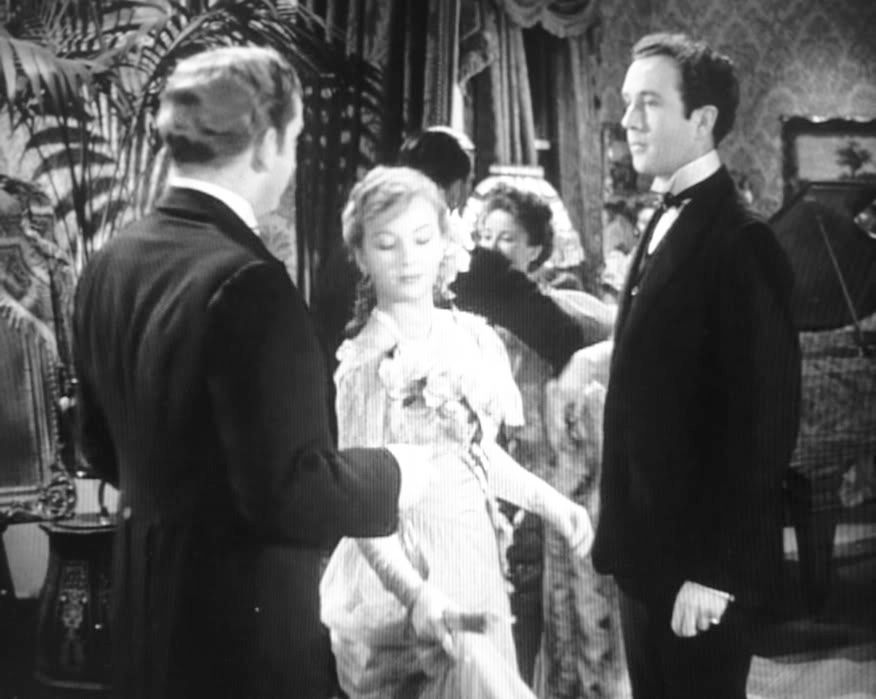
Notice that he is wearing the same sad lounge suit. It is not even a dinner jacket. In the middle is his childhood sweetheart, and to the left (unbeknownst to him) is her new fiancée. He dances with her:
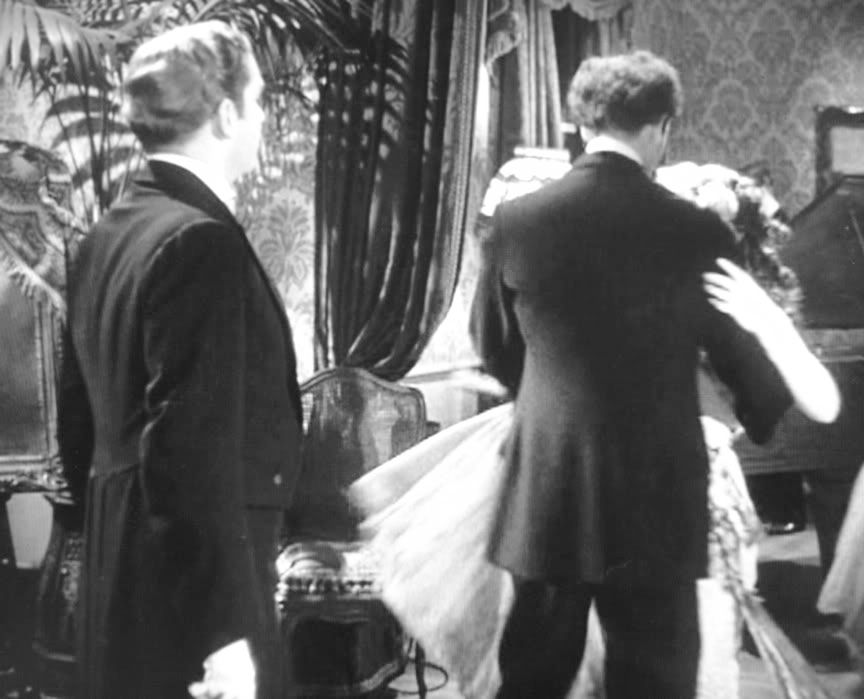
And in this shot, you can clearly see that her new fiancée is wearing a dress coat. He can afford it, and is thus turned out correctly dressed for the occasion, rather than being reduced to making do with the same miserable lounge coat for all social outings. Mazzini still naively takes her aside to propose to her only to be rejected.
Here he proposes to her, and, as you can see, he is trying disparately to dress up his lounge by wearing a bow tie and detachable stand up collar as ersatz evening dress:

To add insult to injury, who else then walks in to his store, but the Duke of Chalfont himself. Not knowing who Mazzini is, the Duke treats the humble clerk with utter contempt, and on protesting his treatment is promptly fired, kindling his first murderous thoughts.
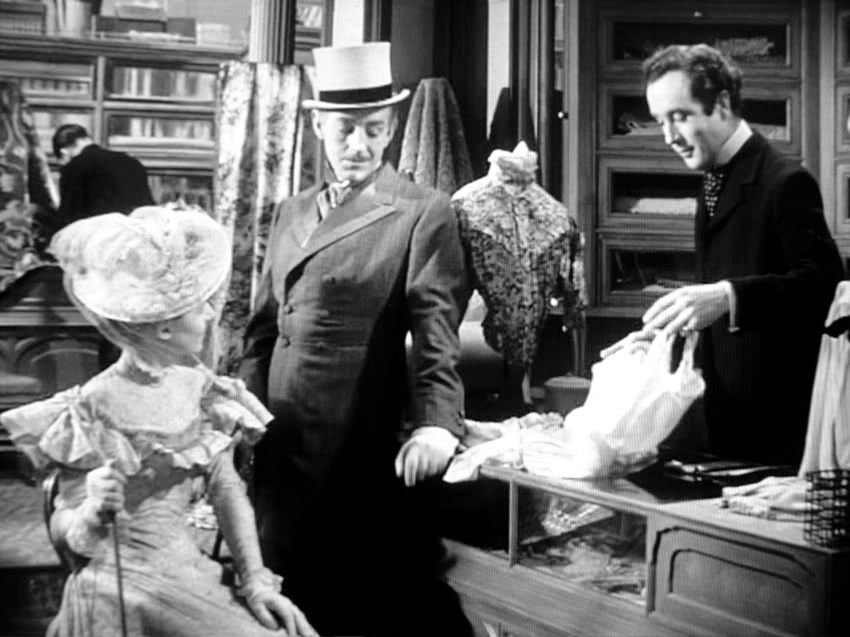
Notice, the huge discrepancy between the way the Duke and Mazzini are dressed. Firstly, the Duke wears a fashionable somewhat informal frock coat - in a dandified light grey colour with pinstripes. The Duke obviously even dresses extravagantly even when out shopping with his mistress. Notice the beautiful, light coloured grey top hat and silk facings on the lapels that add to the over-the-top hauteur of the Duke:
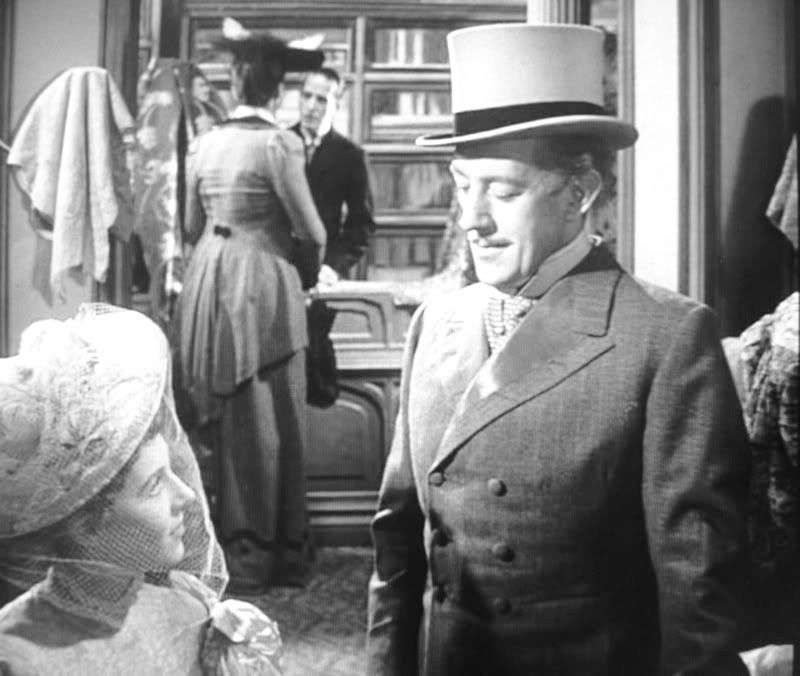
In this age, smart casual would have generally have been a lounge suit or a morning coat, and this was extravagant for its time.
Still, Mazzini valiantly tries to keep up appearances in the face of his indignant treatment:

Here, he wears an Edwardian styled SB high buttoning lounge coat worn with detachable winged collar and cravat.
So he sets out to avenge his treatment and his mother to murder his way to the Dukedom. So, he tracks the Duke down to a country resort:

His dandified manner is an indication of his increasingly ambitious aspirations. It is a beautiful three piece (presumably linen) pinstripe resort wear lounge suit for beach and country resort accesorised with boater hat and walking stick. Notice too the man on the right wearing a brightly coloured striped blazer (in the correct and proper sense of the term). Then he finds his victim:
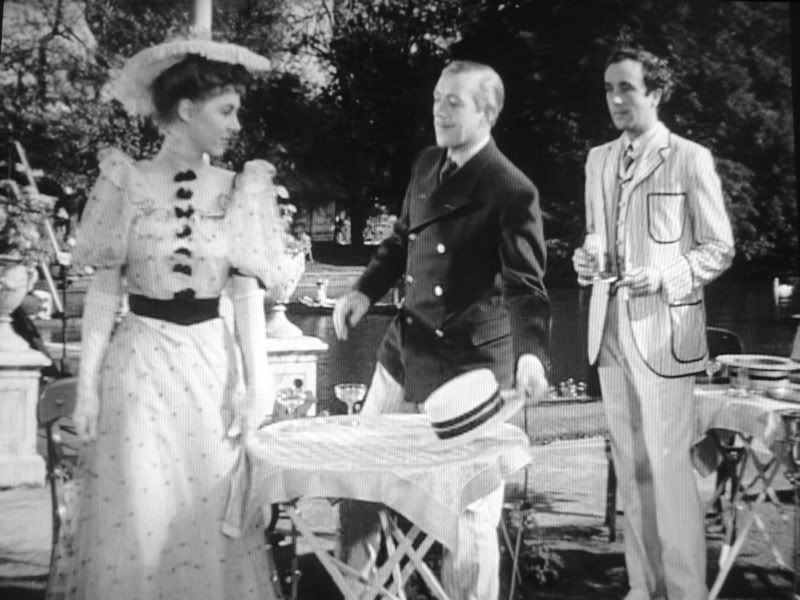
The Dukes wears a reefer jackets (blazer in the modern corrupt usage) with cream coloured (probably linen or flannel) trousers. Notice, the 6x3 configuration.
Next in line is this old chap. Notice the frock coat and the waistcoat with the understated window pane check:
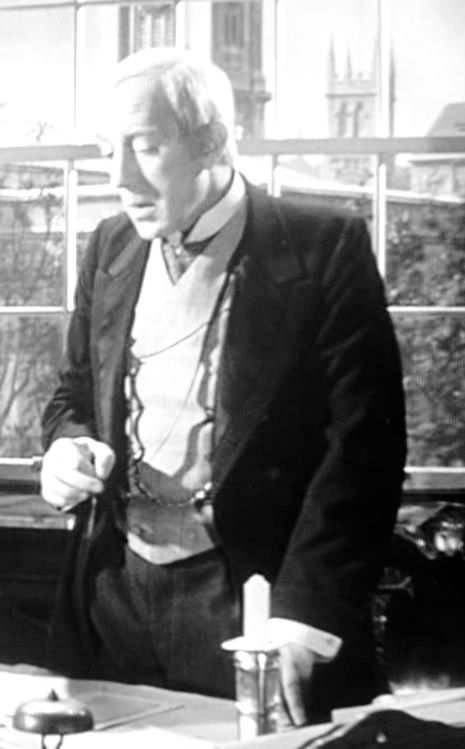
He turns out to be a kindly old man, treating Mazzini well. Fortunately, he gives him employment before dying of natural causes eventually, sparing him of a sticky end at Mazzini's hands. In the meanwhile Mazzini pursues the next in line, a fanatical photography enthusiast:
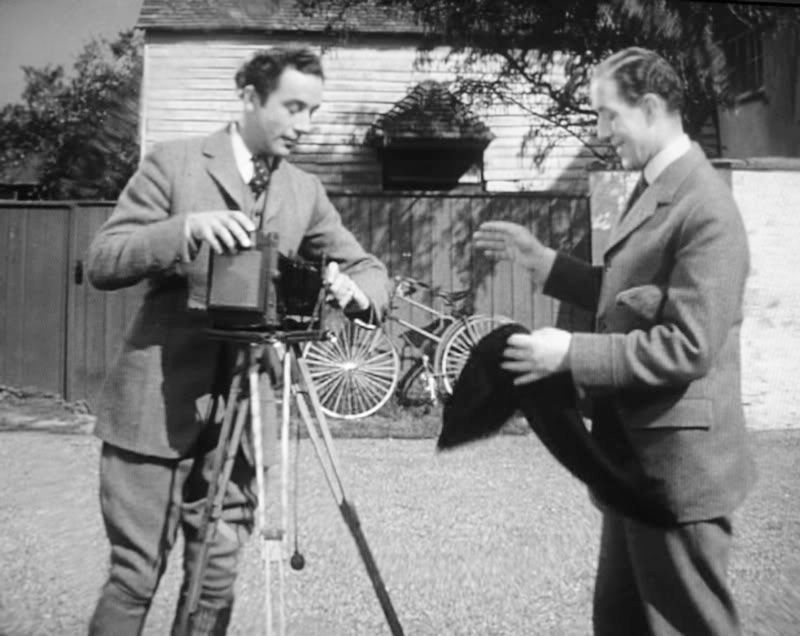
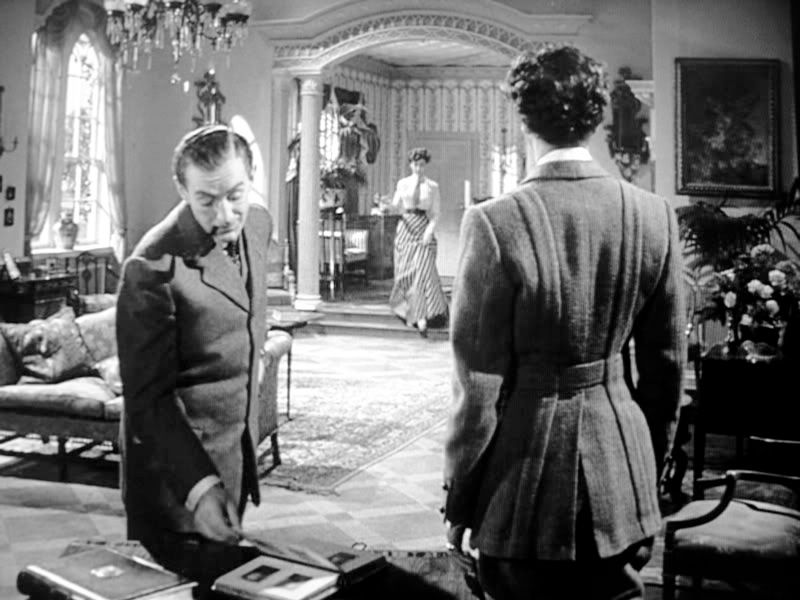
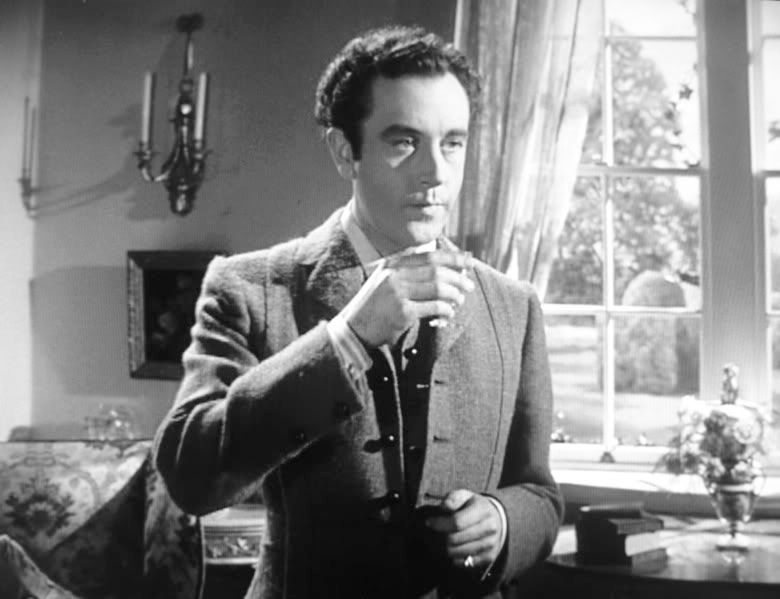
To visit his victim on his country estate he plays the role of fellow photography enthusiast in his beautifully tailored Norfolk jacket and matching two pluses.
Now, he attends his sweetheart's wedding. However, this time he is able to dress properly for the occasion:
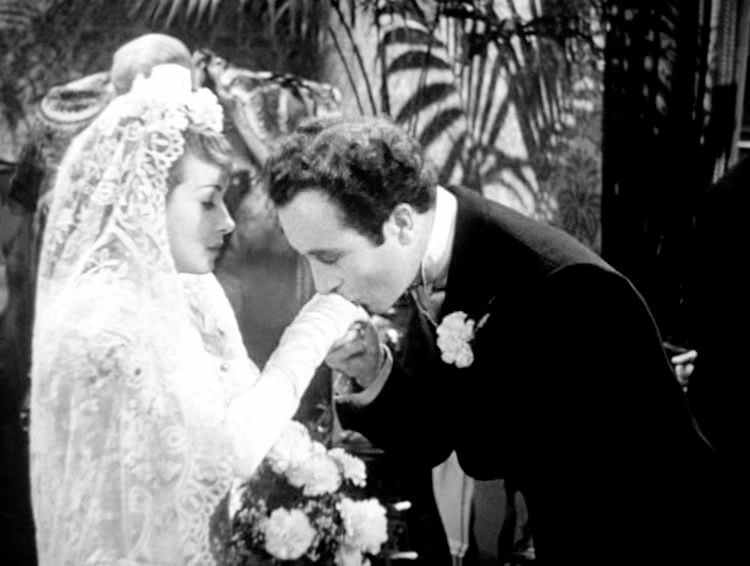
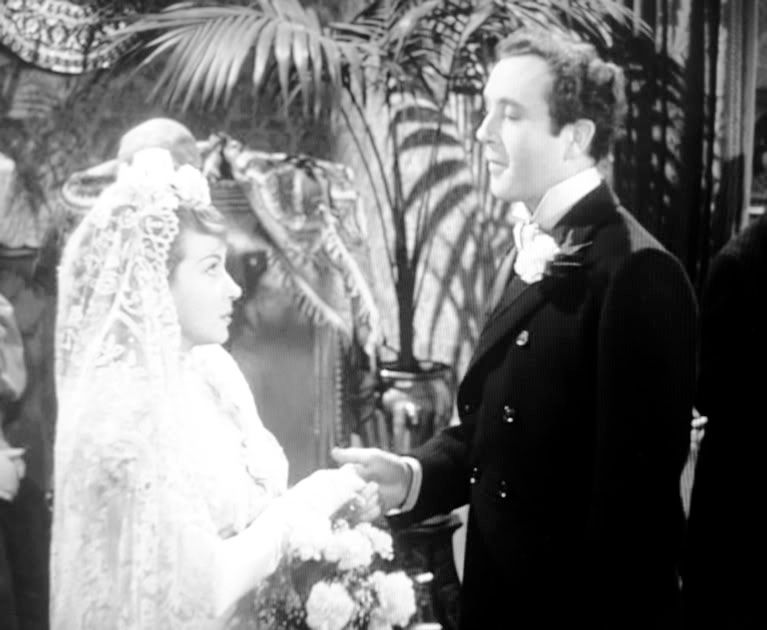
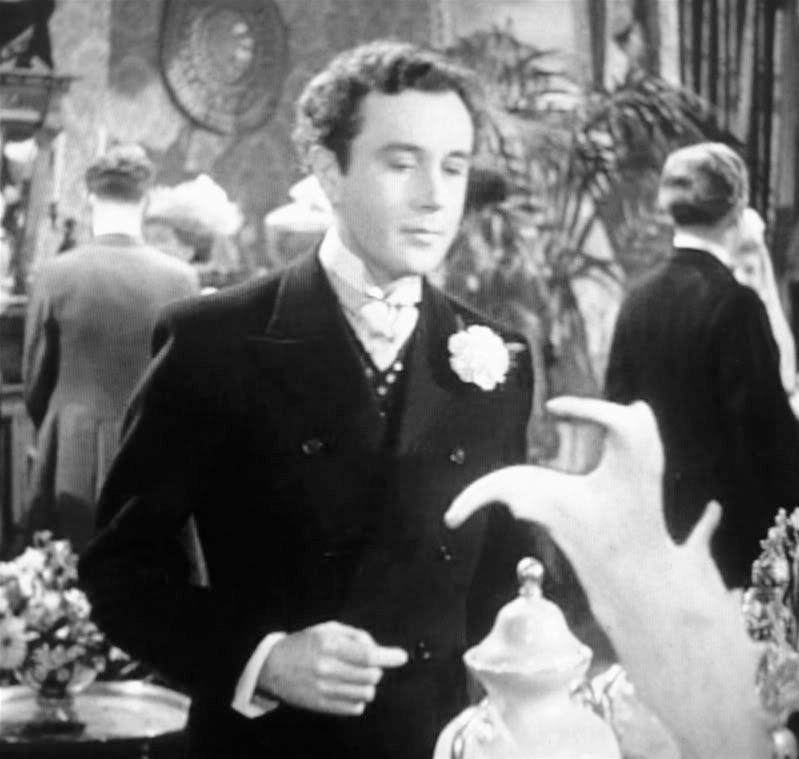
This has to be the ensemble of the film. The 6x2 frock coat is beautifully tailored, following the contours of the body perfectly. The show buttons are aligned with the other buttons in the authentic period manner. Notice the exquisite waistcoat (silk?) with tastefully dandified dots and the boutonnière. Here he congratulates the bridegroom:
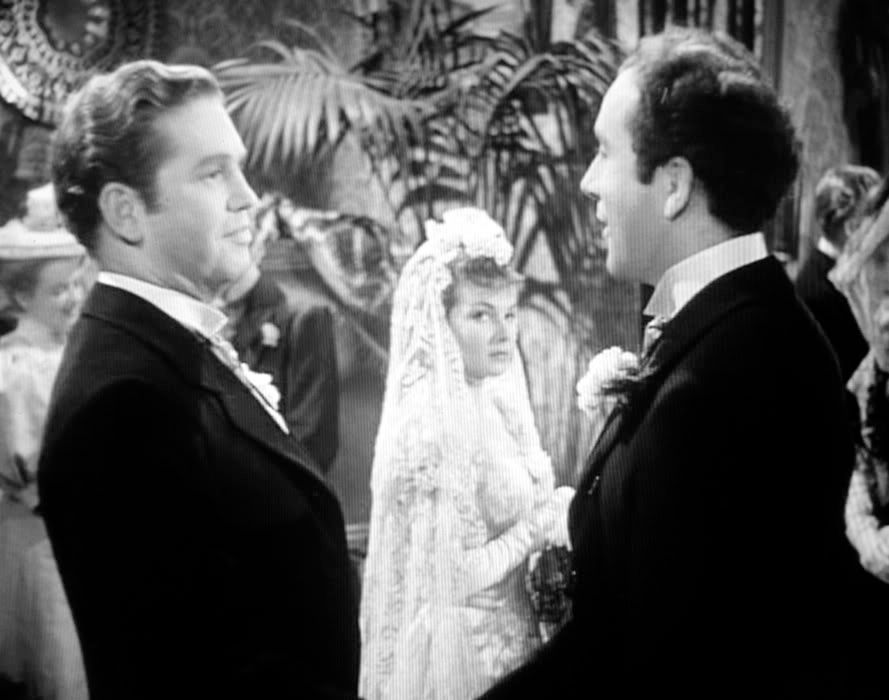
The dress says it all. The tables have been turned. In contrast to the last scene, the bridegroom now wears a humble morning coat (with mere step collar!) and is totally outdressed and outclassed by the guest in his stunning frock coat. The look on the bride's face is priceless.
Here, for interest, is Edward VII (the the Prince of Wales) in a morning coat. The morning coat, 'dressy without being formal', was regarded as being suitable wear for skating in the 1890's:
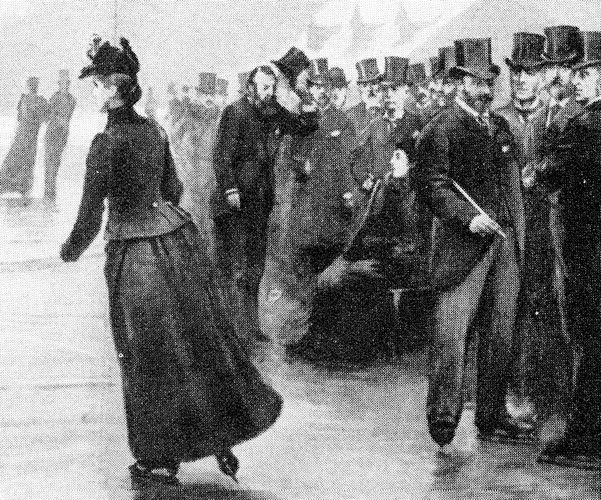
He goes back to work:
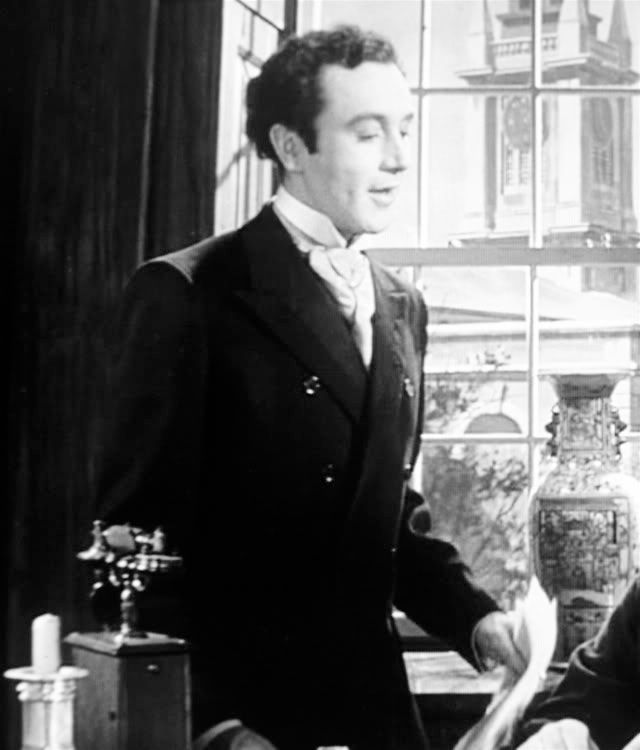
This was unusually dandified in an age when younger men increasingly went to work in a morning coat and striped trousers. I do wish that they had made a matching black waistcoat for work, rather than have the character wear the same clothes to work as to a wedding:
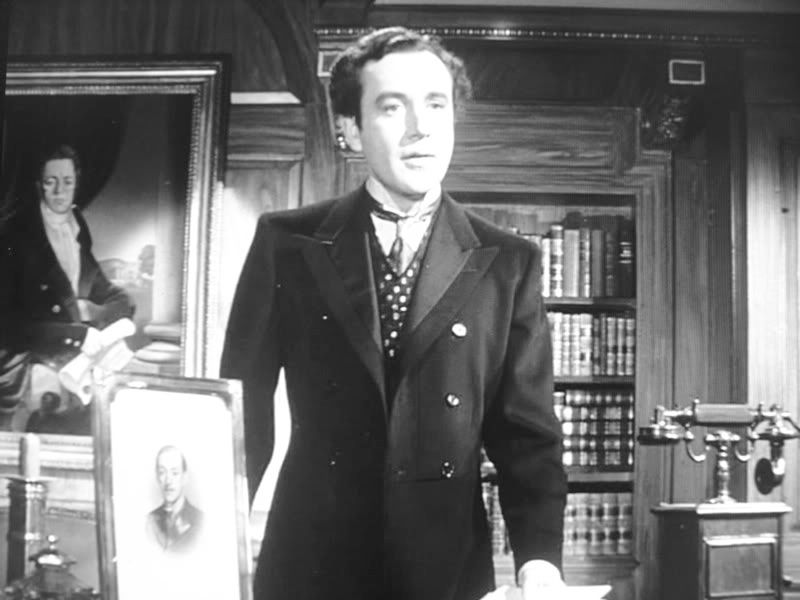
The waistcoat is a bit too fancy for work. In this shot you can clearly see that the lapels have been cut separately by the seam running vertically parallel to the lapels.
One symptom of his new found hauteur is that he still wears lounge coats, but only in its 'proper' setting for casual lounging at home:

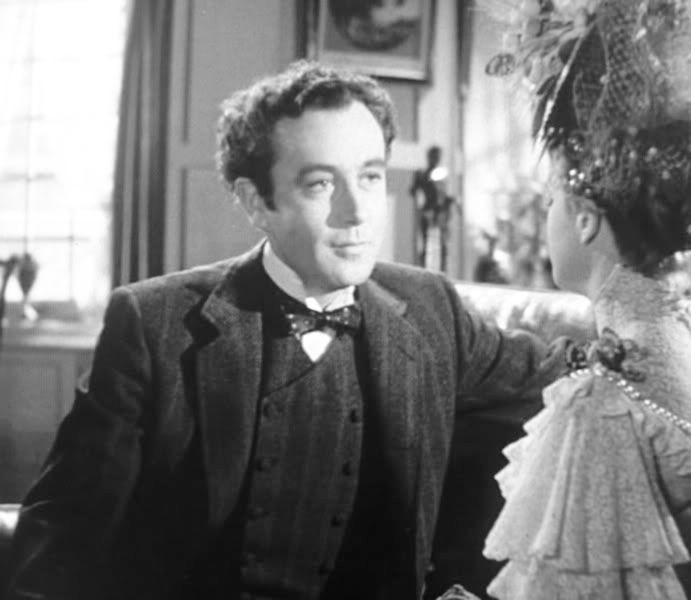
Even then the waistcoat is a fancy high buttoning double breasted one. Notice the gramophone - the trappings of luxury.
In another scene, he receives a visit from his old sweetheart, whom he receives in his breathtakingly lavish silk 'house coat':

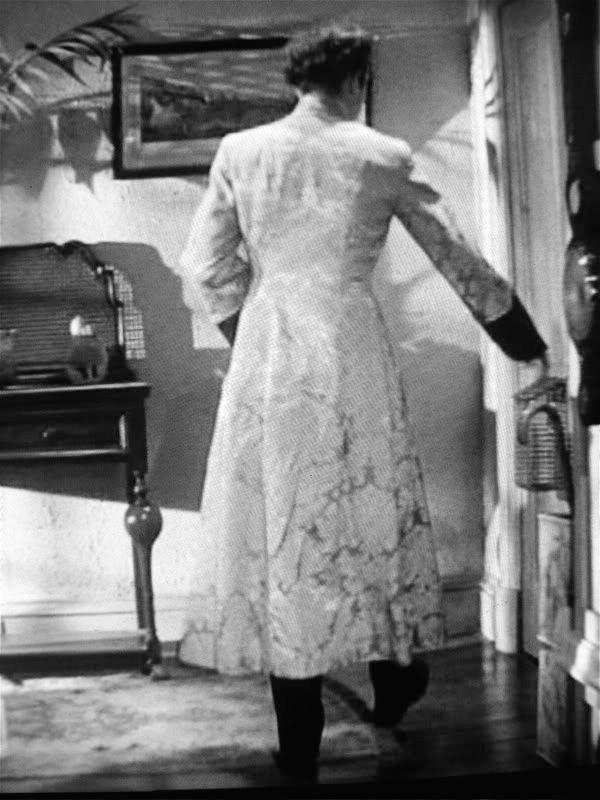
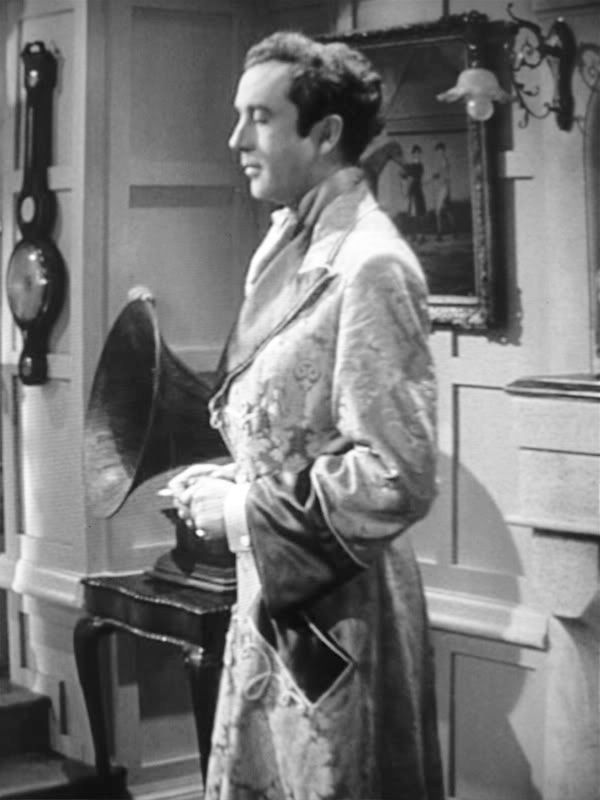
This coat is simply extraordinary in its beauty. Notice how strongly waisted it is in a manner that could only be bespoke. This has to be another highlight of the film alongside the frock coat for the wedding.
Next, he visits the widow of one of his victims on her country estate. For that occasion he wears a single breasted window pane frock coat suit with pointed collars and unusual flapped pockets:
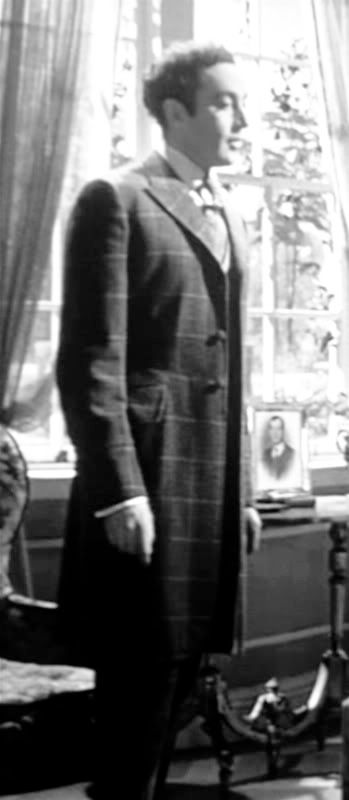
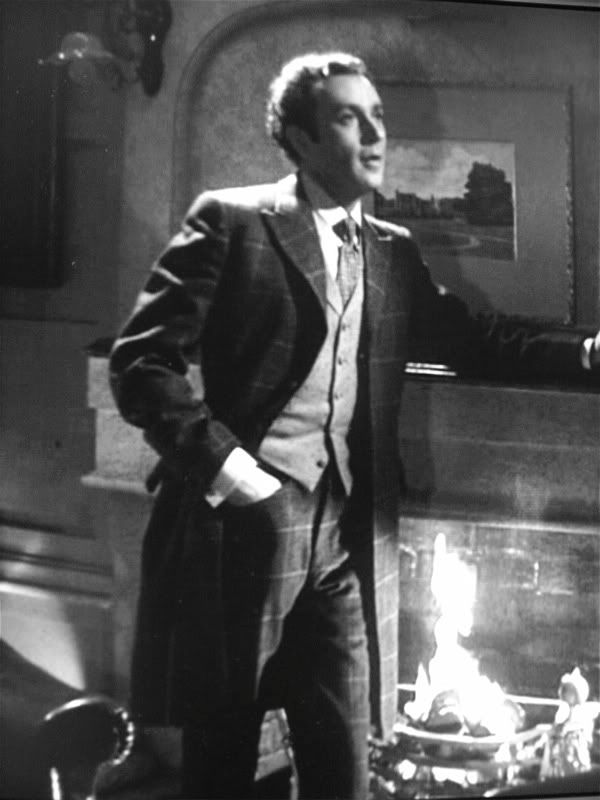

Many informal frock coat suits of the time were still double breasted and without side pockets:

Next, he meets with his sweetheart's husband who is now bankrupt:

The reversal in the two men's fortunes is now complete. Now, it is Mazzini in his stunning single breasted frock coat suit with satin lapels versus his adversary reduced to wearing a humble lounge coat. The fellow in his miserable lounge suit goes on his knees and begs Mazzini in his frock coat for help:

But, the cold blooded fellow in the frock coat stands there stone-faced and unmoved by his desperate pleas:
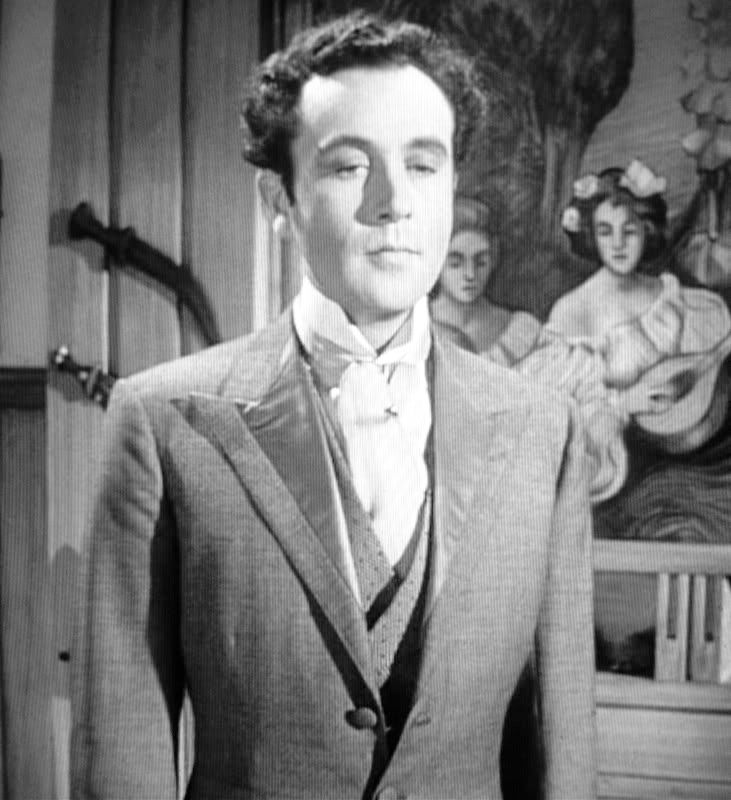
The decadent eloquence of the silk faces single breasted frock coat with silk lapels is all too obvious. He has now become like the murdered Duke in the earlier scene with his light grey double breasted frock coat and silk lapels.
In the meantime, he manages to get himself invited to dinner with his next victim. The host wears a dinner jacket at home, while the guest wears a dress suit:
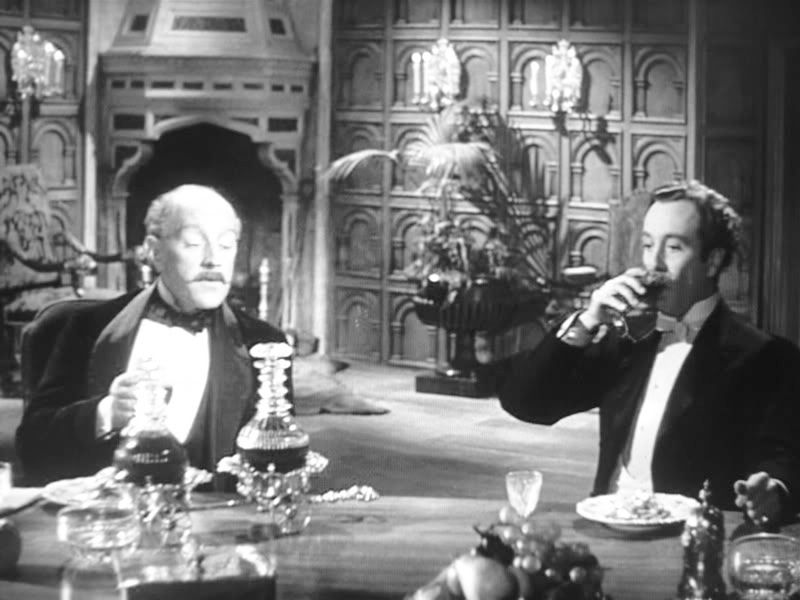
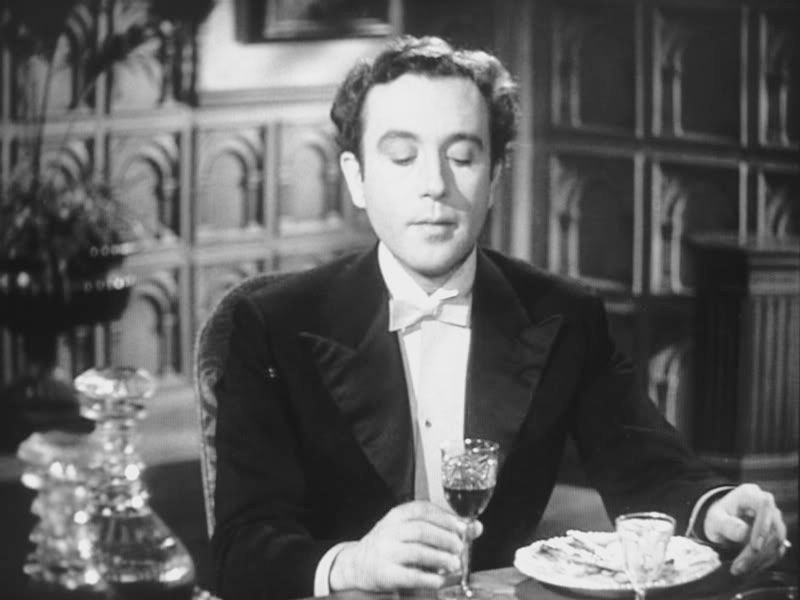
Notice the similarity in the style of the lapels to other coats suggesting that the same tailor made most of them.
In the company of his final victim and barrier to the Dukedom, he wears a tweed hunting jacket:
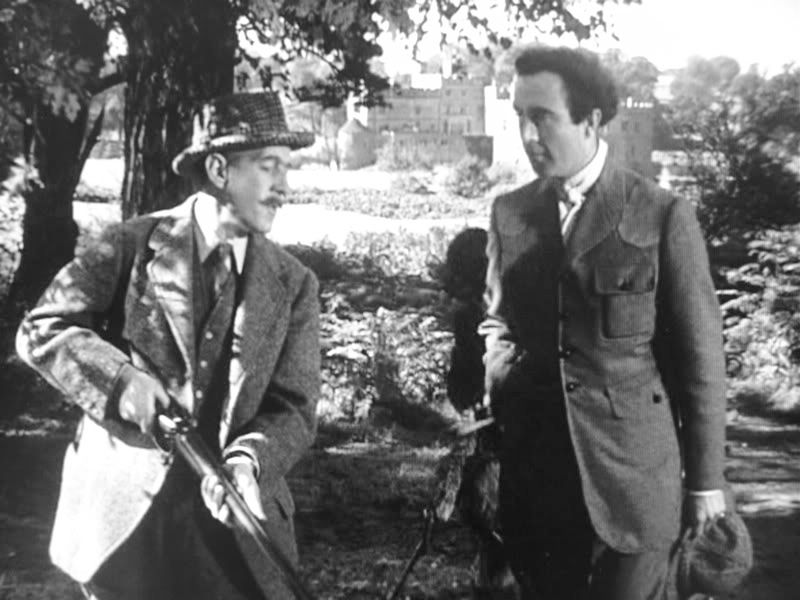
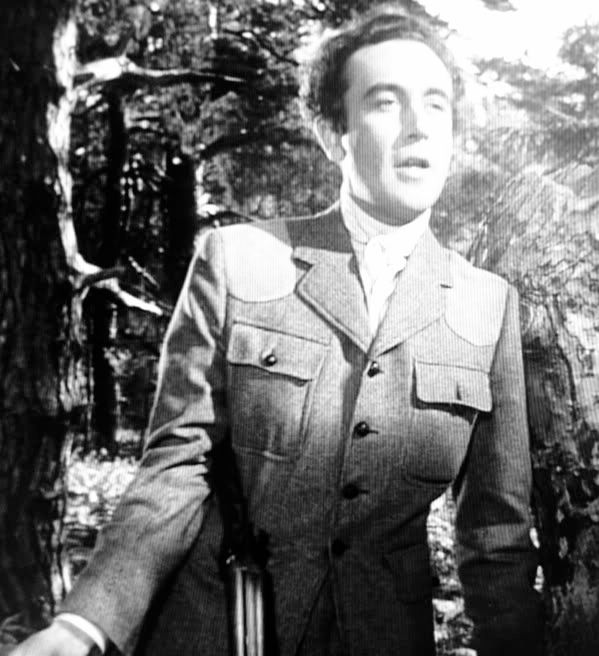
He manages to explain to his victim, trapped in a fox trap, that he is avenging his wronged mother. Notice the shoulder reinforcements for shooting, and flaps on all pockets.
He marries the widow of a victim:
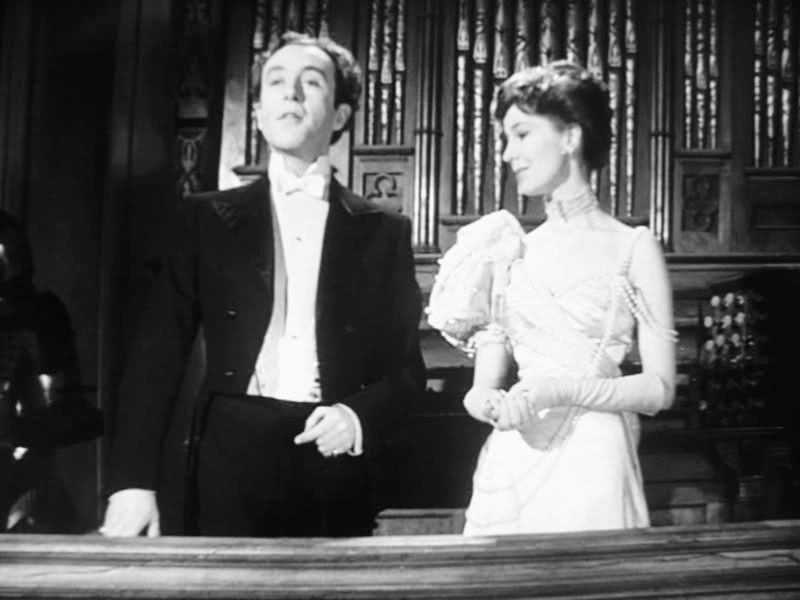
At the wedding, he is visited by a Scotland Yard detective in his caped Ulster coat:
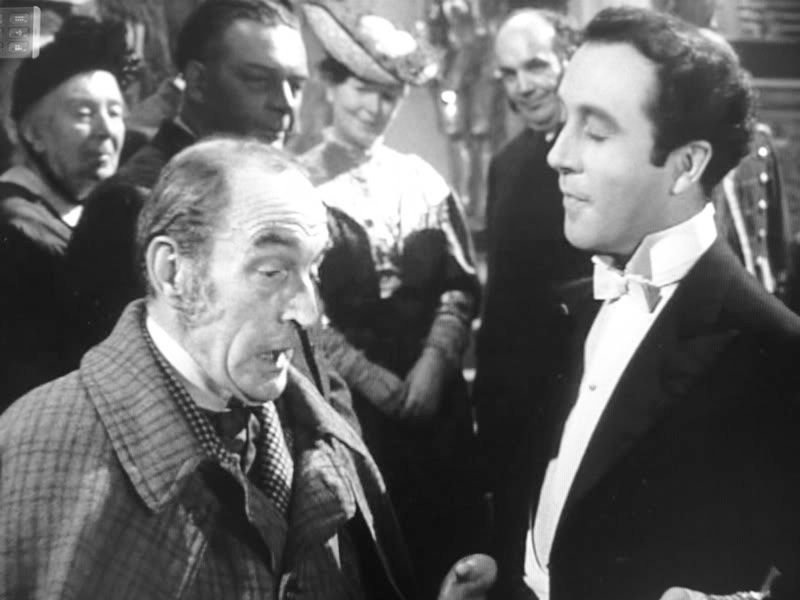
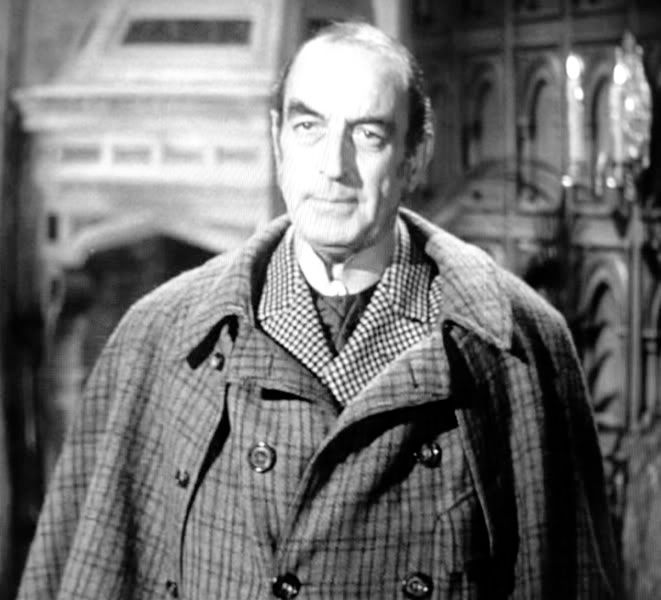
He is a suspect of a murder - of the bankrupt husband of his sweetheart, even though he has actually committed suicide. Notice the rather late Victorian Sherlock Holmes appearance of the detective with the check on check combination.
At court, he chooses to wear his single breasted frock coat suit:
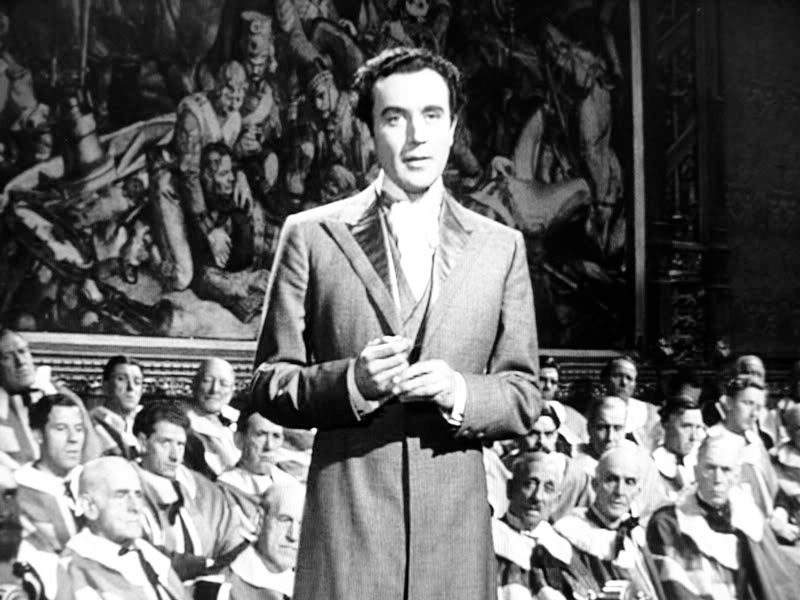
In the final irony, he is convicted of a murder he never committed. The Duke is condemned to hang and the doomed man enjoys his final night in prison wearing his smoking jacket, while enjoying wine and grapes:
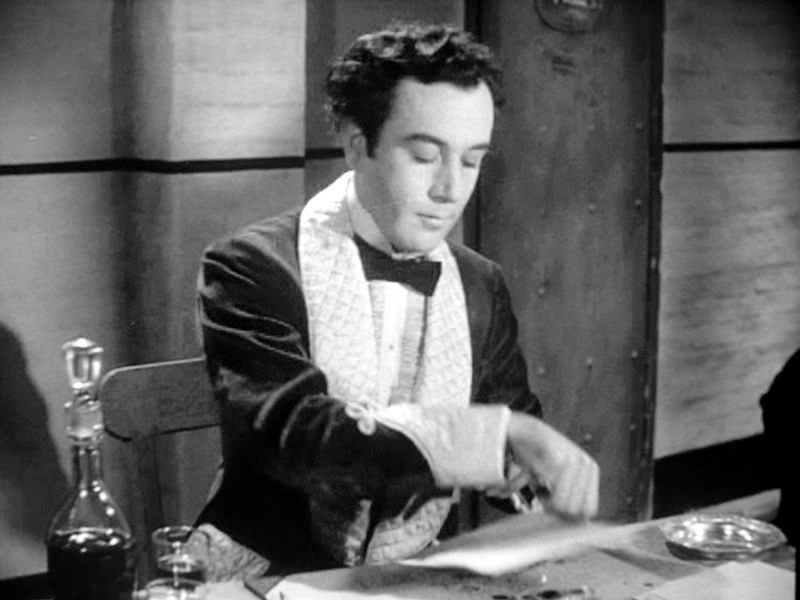
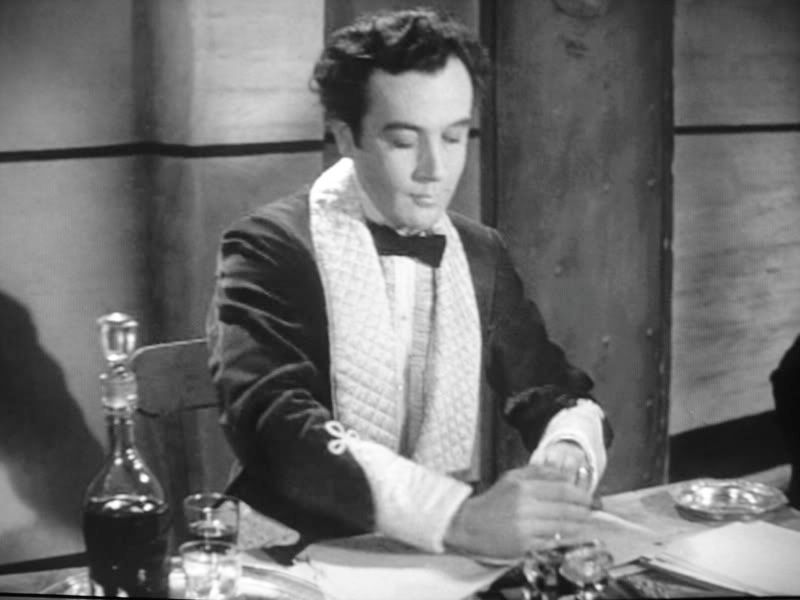
What an extraordinarily decadent smoking jacket that is with those quilted silk roll collars! I am speechless.
However, his old sweetheart appears at the eleventh hour, promising to 'find' her late husband's suicide note if Mazzini promises to marry her (after doing away with his current wife). He agrees and is set free to leave prison in his Inverness cloak:
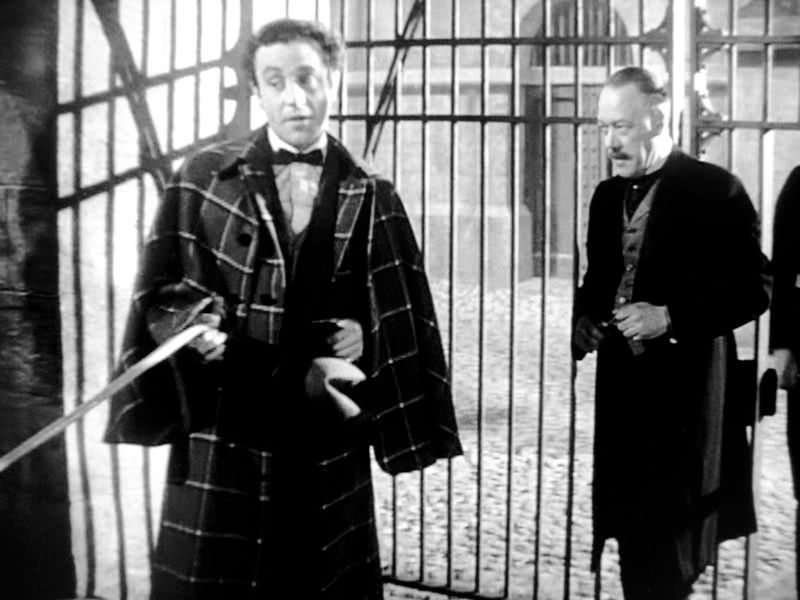
I won't spoil the ending, which I shall leave to the reader to find out. But as you can see, this is an extraordinary tour de force of fine dress.
I hope you have enjoyed it.

This delicious 1949 British black comedy is set in the Edwardian era starring Dennis Price playing Louis Mazzini as a distant heir to a dukedom, but with eight members of the D'Ascoyne family standing in his way. He vows to avenge the premature death of his beloved mother who dies in poverty after being ostracised by her family for marrying below her station, after eloping with an Italian opera singer. Mazzini sets out to murder his way to the Dukedom of Chalfont, with each of his victims played to hilarious effect by Alec Guiness - even Lady Agatha D'Ascoyne.
The DVD is widely available and is highly recommended as a splendid film in its own right, shot in a sumptuous black and white. However, what interests us today is the extraordinary care taken in recreating Edwardian dress. As Mazzini slowly murders his way up the social ladder, his manner of dress, starting as a humble store clerk in a lounge coat, becomes increasingly extravagant and dandified, in keeping with the growing hubris of the character.
In the Male Image, Penelope Bryde writes of the Edwardian era:
With that let us move onto to seeing pictures of how Dennis Price is dressed in the film. It will be patently obvious to all here that every single garment is a bespoke item. One look at the fit of the garments says all. The range of different coats cut for him are something of a tour de force of the Edwardian dress recreated with remarkable historical accuracy and recreates beautifully the spirit of the age as describe by Byrde. Unlike with modern period films, I can detect almost no obvious violations of Edwardian dress codes - with one exception, when Mazzini wears a frock coat with silk faced lapels to the funeral of one his victims. For funerals frock coats should be self faced. But that is the only transgression, and a subtle one at that.The first decade of the twentieth century, or more precisely, the reign of Edward VII from 1901-1910 is often regarded as a high point in the history of men's fashion, a period of considerable style and refinement. In comparison with the years which followed, the Edwardian era seems to have been in almost every way a time of great opulence, gaiety, and frivolity inspired and encouraged by the monarch himself. From the point of view of men's dress, Edward VII was undoubtedly a revered and influential figure; he was passionately interested in clothes, and was to a certain extent something of an innovator. His father considered that as a young man 'he took no interest in anything but clothes, and that even out shooting was more concerned with his trousers than with the game.' It has been recorded that 'the Prince did not in the least mind changing his dress half a dozen times a day. He loved clothes and ... had so many he could never travel with less than two valets; and two more valets were left at home cleaning, brushing, and pressing his vast wardrobe.'
In some ways the Edwardian period appears to have reacted against the straight-laced atmosphere of the Victorian age but strict social conventions hardly relaxed before the outbreak of the First World War and clothes remained formal, governed by clearly-defined rules of etiquette. Edward VII occasionally wore a lounge suit instead of a frock coat but the frock coat was still correct for formal day wear and a lounge suit could not be worn at an office in the City. A morning coat with striped trousers and a top hat was worn for work and most men changed in the evening. Mass produced clothes had not yet reached a wide market and, for any man with the least pretension to gentlemanliness, cut was all important (the idea that 'the apparel oft proclaims the man' still held good).
The frock coat was nearing the end of its fashionable life and even in 1900 it tended to be worn by elderly rather than young men. By this date it was usually double breasted with four or six buttons, generally worn open; it was black or sometimes grey and was accompanied by either matching, striped or checked trousers.
For morning or business wear the morning coat was usual but the lounge suit was a less formal alternative. Morning dress could take two forms, either it consisted of the black morning coat with striped or check trousers and contrasting waistcoat, or it was a matching suit - coat, waistcoat and trousers all being of the same material (often checked tweed). Unlike the frock coat it was almost always single breasted fastening with three or four buttons, and was several inches shorter than the frock coat. The correct waistcoat was also single breasted. Edward VII is popularly thought to have originated the fashion for wearing the lowest button of the waistcoat undone, having dressed hurriedly one day and omitted to fasten it, but in view of the King's attitude to clothes this is most unlikely. The habit was noted by the Tailor and Cutter in 1908, but it has a much earlier history. Many eighteenth century waistcoats were only fastened at the waist, the lower buttons and buttonholes being either sham or left unfastened. A vestige of this custom remained in nineteenth century men's suits and from at least the 1820's onwards waistcoats with the lowest button undone can be seen.
Unable to afford an education, and forced into a trade as a petty store clerk, Mazzini can only afford to buy a humble lounge coat for his work:

Notice the rounded collars on the shirt worn with a three piece lounge coat.
Here he is at a dinner party:

Notice that he is wearing the same sad lounge suit. It is not even a dinner jacket. In the middle is his childhood sweetheart, and to the left (unbeknownst to him) is her new fiancée. He dances with her:

And in this shot, you can clearly see that her new fiancée is wearing a dress coat. He can afford it, and is thus turned out correctly dressed for the occasion, rather than being reduced to making do with the same miserable lounge coat for all social outings. Mazzini still naively takes her aside to propose to her only to be rejected.
Here he proposes to her, and, as you can see, he is trying disparately to dress up his lounge by wearing a bow tie and detachable stand up collar as ersatz evening dress:

To add insult to injury, who else then walks in to his store, but the Duke of Chalfont himself. Not knowing who Mazzini is, the Duke treats the humble clerk with utter contempt, and on protesting his treatment is promptly fired, kindling his first murderous thoughts.

Notice, the huge discrepancy between the way the Duke and Mazzini are dressed. Firstly, the Duke wears a fashionable somewhat informal frock coat - in a dandified light grey colour with pinstripes. The Duke obviously even dresses extravagantly even when out shopping with his mistress. Notice the beautiful, light coloured grey top hat and silk facings on the lapels that add to the over-the-top hauteur of the Duke:

In this age, smart casual would have generally have been a lounge suit or a morning coat, and this was extravagant for its time.
Still, Mazzini valiantly tries to keep up appearances in the face of his indignant treatment:

Here, he wears an Edwardian styled SB high buttoning lounge coat worn with detachable winged collar and cravat.
So he sets out to avenge his treatment and his mother to murder his way to the Dukedom. So, he tracks the Duke down to a country resort:

His dandified manner is an indication of his increasingly ambitious aspirations. It is a beautiful three piece (presumably linen) pinstripe resort wear lounge suit for beach and country resort accesorised with boater hat and walking stick. Notice too the man on the right wearing a brightly coloured striped blazer (in the correct and proper sense of the term). Then he finds his victim:

The Dukes wears a reefer jackets (blazer in the modern corrupt usage) with cream coloured (probably linen or flannel) trousers. Notice, the 6x3 configuration.
Next in line is this old chap. Notice the frock coat and the waistcoat with the understated window pane check:

He turns out to be a kindly old man, treating Mazzini well. Fortunately, he gives him employment before dying of natural causes eventually, sparing him of a sticky end at Mazzini's hands. In the meanwhile Mazzini pursues the next in line, a fanatical photography enthusiast:



To visit his victim on his country estate he plays the role of fellow photography enthusiast in his beautifully tailored Norfolk jacket and matching two pluses.
Now, he attends his sweetheart's wedding. However, this time he is able to dress properly for the occasion:



This has to be the ensemble of the film. The 6x2 frock coat is beautifully tailored, following the contours of the body perfectly. The show buttons are aligned with the other buttons in the authentic period manner. Notice the exquisite waistcoat (silk?) with tastefully dandified dots and the boutonnière. Here he congratulates the bridegroom:

The dress says it all. The tables have been turned. In contrast to the last scene, the bridegroom now wears a humble morning coat (with mere step collar!) and is totally outdressed and outclassed by the guest in his stunning frock coat. The look on the bride's face is priceless.
Here, for interest, is Edward VII (the the Prince of Wales) in a morning coat. The morning coat, 'dressy without being formal', was regarded as being suitable wear for skating in the 1890's:

He goes back to work:

This was unusually dandified in an age when younger men increasingly went to work in a morning coat and striped trousers. I do wish that they had made a matching black waistcoat for work, rather than have the character wear the same clothes to work as to a wedding:

The waistcoat is a bit too fancy for work. In this shot you can clearly see that the lapels have been cut separately by the seam running vertically parallel to the lapels.
One symptom of his new found hauteur is that he still wears lounge coats, but only in its 'proper' setting for casual lounging at home:


Even then the waistcoat is a fancy high buttoning double breasted one. Notice the gramophone - the trappings of luxury.
In another scene, he receives a visit from his old sweetheart, whom he receives in his breathtakingly lavish silk 'house coat':



This coat is simply extraordinary in its beauty. Notice how strongly waisted it is in a manner that could only be bespoke. This has to be another highlight of the film alongside the frock coat for the wedding.
Next, he visits the widow of one of his victims on her country estate. For that occasion he wears a single breasted window pane frock coat suit with pointed collars and unusual flapped pockets:



Many informal frock coat suits of the time were still double breasted and without side pockets:

Next, he meets with his sweetheart's husband who is now bankrupt:

The reversal in the two men's fortunes is now complete. Now, it is Mazzini in his stunning single breasted frock coat suit with satin lapels versus his adversary reduced to wearing a humble lounge coat. The fellow in his miserable lounge suit goes on his knees and begs Mazzini in his frock coat for help:

But, the cold blooded fellow in the frock coat stands there stone-faced and unmoved by his desperate pleas:

The decadent eloquence of the silk faces single breasted frock coat with silk lapels is all too obvious. He has now become like the murdered Duke in the earlier scene with his light grey double breasted frock coat and silk lapels.
In the meantime, he manages to get himself invited to dinner with his next victim. The host wears a dinner jacket at home, while the guest wears a dress suit:


Notice the similarity in the style of the lapels to other coats suggesting that the same tailor made most of them.
In the company of his final victim and barrier to the Dukedom, he wears a tweed hunting jacket:


He manages to explain to his victim, trapped in a fox trap, that he is avenging his wronged mother. Notice the shoulder reinforcements for shooting, and flaps on all pockets.
He marries the widow of a victim:

At the wedding, he is visited by a Scotland Yard detective in his caped Ulster coat:


He is a suspect of a murder - of the bankrupt husband of his sweetheart, even though he has actually committed suicide. Notice the rather late Victorian Sherlock Holmes appearance of the detective with the check on check combination.
At court, he chooses to wear his single breasted frock coat suit:

In the final irony, he is convicted of a murder he never committed. The Duke is condemned to hang and the doomed man enjoys his final night in prison wearing his smoking jacket, while enjoying wine and grapes:


What an extraordinarily decadent smoking jacket that is with those quilted silk roll collars! I am speechless.
However, his old sweetheart appears at the eleventh hour, promising to 'find' her late husband's suicide note if Mazzini promises to marry her (after doing away with his current wife). He agrees and is set free to leave prison in his Inverness cloak:

I won't spoil the ending, which I shall leave to the reader to find out. But as you can see, this is an extraordinary tour de force of fine dress.
I hope you have enjoyed it.